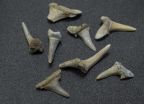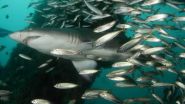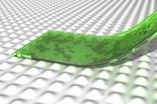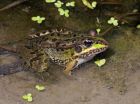(Press-News.org) A new study shows that some shark species may be able to cope with the rising salinity of Arctic waters that may come with rising temperatures.
The Arctic today is best known for its tundra and polar bear population, but it wasn't always like that. Roughly 53 to 38 million years ago during what is known as the Eocene epoch, the Arctic was more similar to a huge temperate forest with brackish water, home to a variety of animal life, including ancestors of tapirs, hippo-like creatures, crocodiles and giant tortoises. Much of what is known about the region during this period comes from well-documented terrestrial deposits. Marine records have been harder to come by.
A new study of shark teeth taken from a coastal Arctic Ocean site has expanded the understanding of Eocene marine life. Leading the study was Sora Kim, the T.C. Chamberlin Postdoctoral Fellow in Geophysical Sciences at the University of Chicago, in coordination with Jaelyn Eberle at the University of Colorado, Boulder, and their three co-authors. Their findings were published online June 30 by the journal Geology.
The Arctic is of special interest today because it is increasing in temperature at twice the global rate. According to Kim, past climate change in the Arctic can serve as a proxy to better understand our current climate change and aid future predictions. The Eocene epoch, she said, is like a "deep-time analogue for what's going to happen if we don't curb CO2 emissions today, and potentially what a runaway greenhouse effect looks like."
Before this study, marine records primarily came from deep-sea cores pulled from a central Arctic Ocean site, the Lomonosov Ridge. Kim and Eberle studied shark teeth from a new coastal site on Banks Island. This allowed them to better understand the changes in ocean water salinity across a broader geographic area during a time of elevated global temperatures. Shark teeth are one of the few available vertebrate marine fossils for this time period. They preserve well and are incredibly abundant.
To arrive at their results, Kim isolated and measured the mass ratio of oxygen isotopes 18 to 16 found in the prepared enameloid (somewhat different from human tooth enamel) of the shark teeth. Sharks constantly exchange water with their environment, so the isotopic oxygen ratio found in the teeth is directly regulated by water temperature and salinity. With assumptions made about temperatures, the group was able to focus on extrapolating salinity levels of the water.
The results were surprising. "The numbers I got back were really weird," Kim said. "They looked like fresh water." The sand tiger sharks she was studying are part of a group called lamniform sharks, which prefer to stay in areas of high salinity.
"As more freshwater flows into the Arctic Ocean due to global warming, I think we are going to see it become more brackish," said Eberle, associate professor of geological sciences at CU-Boulder. "Maybe the fossil record can shed some light on how the groups of sharks that are with us today may fare in a warming world."
Because the teeth are 40 to 50 million years old, many tests were run to eliminate any possible contaminates, but the results were still the same. These findings suggest that sharks may be able to cope with rises in temperature and the subsequent decrease of water salinity. It has long been known that sharks are hardy creatures. They have fossil records dating back some 400 million years, surviving multiple mass extinctions, and have shown great ecological plasticity thus far.
Additionally, these results provide supporting evidence for the idea that the Arctic Ocean was most likely isolated from global waters.
"Through an analysis of fossil sand tiger shark teeth from the western Arctic Ocean, this study offers new evidence for a less salty Arctic Ocean during an ancient 'greenhouse period,'" said Yusheng (Chris) Liu, program director in the National Science Foundation (NSF)'s Division of Earth Sciences, which co-funded the research with NSF's Division of Polar Programs. "The results also confirm that the Arctic Ocean was isolated during that long-ago time."
While Kim has hopes to expand her research both geographically and in geologic time in an effort to better understand the ecology and evolution of sharks, she remarked that "working with fossils is tricky because you have to work within the localities that are preserved. "You can't always design the perfect experiment."
INFORMATION: END
Shark teeth analysis provides detailed new look at Arctic climate change
2014-07-09
ELSE PRESS RELEASES FROM THIS DATE:
Making a more healthful, low-fat hot dog without giving up texture
2014-07-09
With grilling season upon us, many backyard cooks are turning to more healthful alternatives to their savored but fatty hot dogs. But low fat can sometimes mean low satisfaction. Now researchers are reporting new progress toward addressing the texture problem in low-fat wieners that are made with olive oil rather than pork fat. Their study was published in ACS' Journal of Agricultural and Food Chemistry.
Ana M. Herrero and colleagues note that hot-dog consumers have come to expect just the right amount of chewiness and springiness, among other things, from their beloved ...
Tiny DNA pyramids enter bacteria easily -- and deliver a deadly payload
2014-07-09
Bacterial infections usually announce themselves with pain and fever but often can be defeated with antibiotics — and then there are those that are sneaky and hard to beat. Now, scientists have built a new weapon against such pathogens in the form of tiny DNA pyramids. Published in the journal ACS Applied Materials & Interfaces, their study found the nanopyramids can flag bacteria and kill more of them than medicine alone.
David Leong, Jianping Xie and colleagues note that some infectious pathogens can lie in wait, undetectable in the human body or in places that antibiotics ...
My brother's keeper
2014-07-09
This news release is available in French.
Montreal, July 9, 2014 — Whether it's how to throw a ball or put together a puzzle, young children learn a lot from their older siblings. While researchers have long known that brothers and sisters teach each other about the world, most of their observations about this have been made in a lab setting.
A new study recently published in the Journal of Cognition and Development by Concordia University education professor Nina Howe takes that investigation a step further by observing how children interact in their natural habitat: ...
What drives a child to abuse alcohol?
2014-07-09
This news release is available in French. By looking at 40 different factors in 14 year old teens, including brain structure and function, personality, life experiences and genetics, researchers can predict with 70% accuracy who will go on to develop binge drinking within the next two years. Impulsivity, hopelessness, sensation-seeking traits, lack of conscientiousness, and other variables such as life events and a family history of drug use contribute to the likelihood of binge drinking. Whether or not the child had had a single drink at age 14 was a particularly ...
One secret of ancient amber revealed
2014-07-09
The warm beauty of amber was captivating and mysterious enough to inspire myths in ancient times, and even today, some of its secrets remain locked inside the fossilized tree resin. But for the first time, scientists have now solved at least one of its puzzles that had perplexed them for decades. Their report on a key aspect of the gemstone's architecture appears in the ACS journal Analytical Chemistry.
Jennifer Poulin and Kate Helwig of the Canadian Conservation Institute point out that much of the amber we see today had its origins millions of years ago, when it exuded ...
Sunshine vitamin ups bowel cancer survival odds, study finds
2014-07-09
Bowel cancer patients with high levels of vitamin D in their blood are more likely to survive the disease, a study shows.
Patients with the highest levels of vitamin D have half the risk of dying compared with those with the lowest levels, the findings reveal.
The study is the first to correlate total blood levels of vitamin D in bowel cancer patients after their diagnosis – which includes that produced after exposure to sunlight and that obtained from dietary sources – with their long term survival prospects.
The University of Edinburgh team tested blood samples ...
Short circuit in the food web
2014-07-09
Jena (Germany) They are amongst the most numerous inhabitants of the sea: tiny haptophytes of the type Emiliania huxleyi. Not visible to the naked eye, when they are in bloom in spring, they form square kilometer sized patches, they are even visible on satellite images. "Together with other phytoplankton, Emiliania huxleyi is responsible for approximately half of the global photosynthesis output," states Prof. Dr. Georg Pohnert of the Friedrich Schiller University Jena (Germany). In the process the greenhouse gas carbon dioxide – CO2 – is extracted from the atmosphere and ...
Fit for the frontline? New study identifies the hearing requirements of British soldiers
2014-07-09
AUDIO:
The gunshot is a binaural recording using KEMAR, the weapon was an SA80 assault rifle and the microphone is 50m downrange from the firer and approximately 30cm from the bullet...
Click here for more information.
University of Southampton researchers, with assistance from the Ministry of Defence, have conducted the first study to identify the hearing requirements of British soldiers fighting on the frontline.
The study, which provides an important and novel insight into ...
Even geckos can lose their grip
2014-07-09
Not even geckos and spiders can sit upside down forever. Nanophysics makes sure of that. Mechanics researchers at Linköping University have demonstrated this in an article just published in Physical Review E. Knowledge that can be of great industrial benefit.
Geckos and spiders that seem to be able to sit still forever, and walk around upside down have fascinated researchers worldwide for many years. We will soon be able to buy smart new fasteners that hold the same way as the gecko's foot. But the fact is, sooner or later the grip is lost, no matter how little force ...
Frogs have developed rapid defences against the red swamp crayfish
2014-07-09
The common frog is one of the amphibians with the highest distribution in the Iberian Peninsula. It reproduces preferably in permanent areas of water where it comes into contact with the red swamp crayfish, which preys on its larvae. Research carried out by the Spaniard Germán Orizaola from the University of Uppsala (Sweden) confirms that the larvae of these frogs have developed a defensive response to the invasive species. They also have deeper tails and larger bodies if they co-exist with the crayfish.
Numerous invasive organisms are currently spreading outside of their ...





